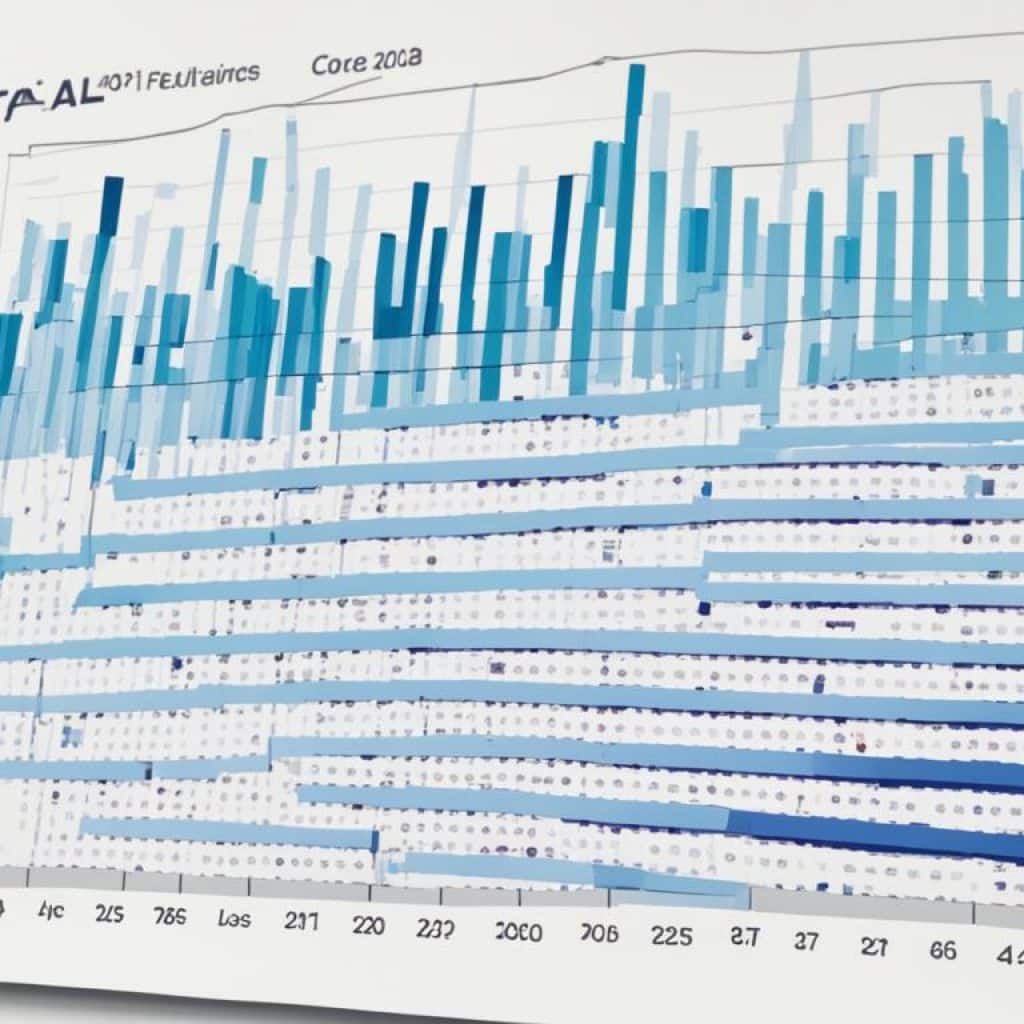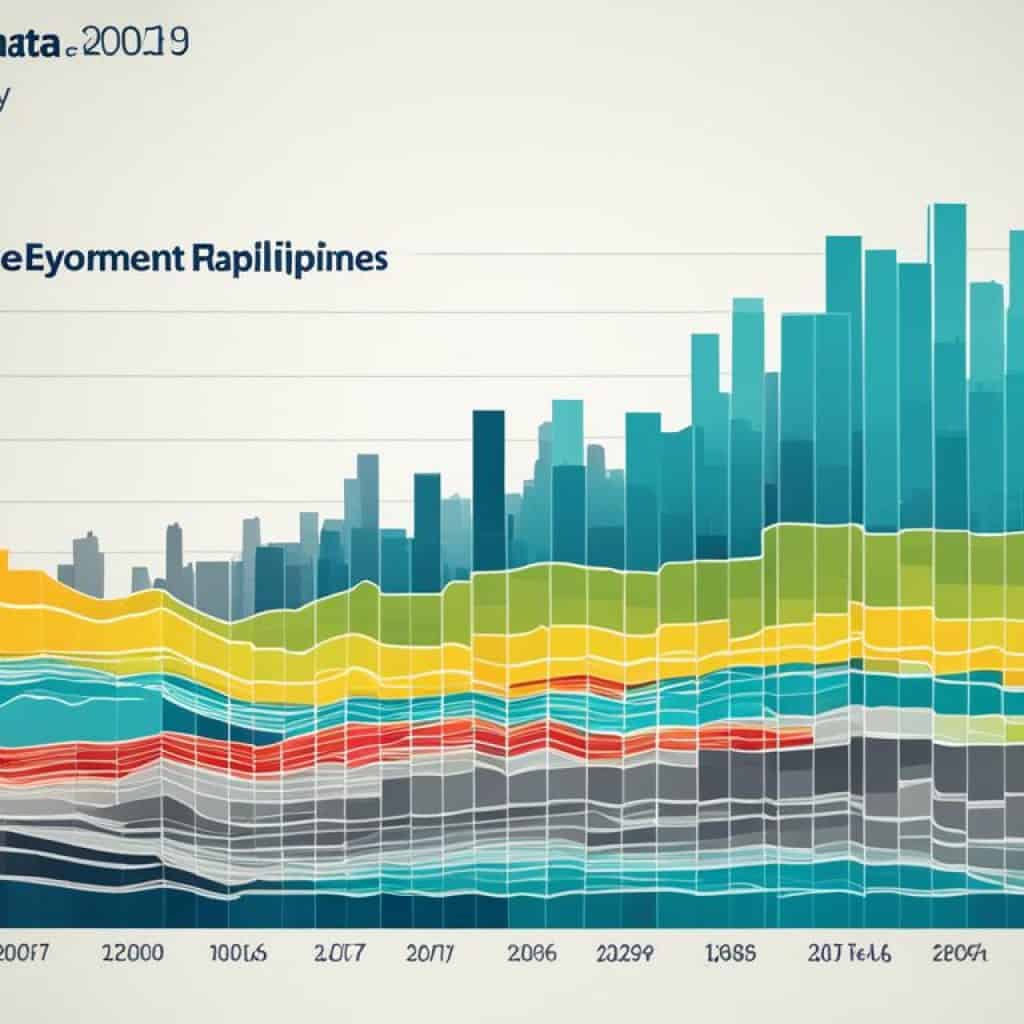What does the future hold for the unemployment rate in the Philippines? Will joblessness decrease in 2024, bringing hope to millions seeking employment? As the country navigates post-pandemic recovery and economic revitalization, economists are keeping a close eye on the job market. Let’s explore the projected trends, factors contributing to unemployment, and potential solutions to address labor market challenges.
Key Takeaways:
- Economists predict an improvement in the unemployment rate in the Philippines in 2024.
- Factors such as economic growth, recovery in tourism, and infrastructure spending are expected to contribute to job creation.
- Gender disparities in unemployment persist, highlighting the need for equal opportunities in the labor market.
- The government’s focus on enhancing the labor market and implementing social protection programs plays a significant role in addressing joblessness.
- Addressing climate change and food security challenges is crucial for sustainable employment and poverty reduction.
Factors Affecting the Unemployment Rate
Several factors contribute to the unemployment rate in the Philippines. Economic growth and inflation play crucial roles in employment creation. The Philippine economy is projected to grow by 6.0% in 2023, which is expected to generate more employment opportunities. Additionally, the government’s focus on infrastructure spending, aiming to reach at least 5-6% of GDP, is expected to stimulate economic growth and provide jobs in various sectors.
The COVID-19 pandemic has greatly impacted industries such as tourism, leading to job losses. However, as tourism and other affected sectors recover, job opportunities are expected to increase. The overall economic outlook for the country remains positive, with rising domestic demand and a rebound in services, particularly in tourism, supporting projected growth.
| Factors | Impact on Unemployment Rate |
|---|---|
| Economic growth | Creates more employment opportunities |
| Inflation | Affects job creation and wages |
| Infrastructure spending | Stimulates economic growth and provides jobs |
| Tourism recovery | Increases job opportunities in the sector |
| Rising domestic demand | Supports overall economic growth and employment |
The projected economic growth and government’s infrastructure spending focus are positive indicators for job creation. As various industries recover from the impacts of the pandemic, the labor market is expected to gain momentum. Rising domestic demand and the rebound of the tourism sector will likely further boost employment opportunities in the Philippines.
Recent Unemployment Trends in the Philippines
Recent data from the Philippine Statistics Authority (PSA) indicates encouraging developments in the country’s labor market. In November 2023, the unemployment rate reached a record low of 3.6%, with only thirty-six out of every 1,000 individuals in the labor force being jobless. This represents a significant improvement compared to the 2.18 million unemployed individuals in November 2022.
The report also highlights certain sectors that experienced notable increases in employment. Industries such as construction, transportation, and storage saw a surge in job opportunities, further contributing to the overall improvement in the unemployment rate.
However, it’s important to note that while the unemployment rate has decreased, the underemployment rate saw a slight increase from October 2023 to November 2023. The underemployment rate measures individuals who are seeking additional work or hours, suggesting that there is still a need for ongoing efforts to address this aspect of the labor market.

Despite this slight increase in underemployment, the overall trend in the labor market is positive, with promising employment opportunities emerging across various sectors. This data underscores the continued need for job market analysis in the Philippines to identify key growth areas and address potential challenges.
Employment Rate and Industry Growth
In November 2023, the Philippines witnessed a promising employment rate of 96.4%, signifying that approximately 49.64 million Filipinos were gainfully employed. This indicates a slight upturn from the preceding month’s figure of 47.80 million individuals who were employed. Various sectors experienced notable growth in employment, contributing to this positive trend. These sectors include:
- Agriculture and Forestry
- Construction
- Transportation and Storage
- Fishing and Aquaculture
- Administrative and Support Service Activities
Moreover, the manufacturing sector sustained expansion, offering significant support to the overall employment rate in the Philippines.

“The robust growth in employment across multiple sectors showcases the resilience of the labor market in the Philippines. With consistent growth and diversification, the country is forging a path towards a more sustainable and inclusive economy.”
Gender Disparities in Unemployment
The Philippine Statistics Authority (PSA) reported gender disparities in unemployment in November 2023. The unemployment rate for males stood at 3.2%, while for females, it was slightly higher at 4.1%. This data highlights the need for focused efforts to address gender inequality in the labor market and ensure equal opportunities for both men and women.
Underemployment and Labor Force Participation
The labor market in the Philippines faces the challenge of underemployment, as indicated by the PSA’s survey in November 2023. The survey revealed that 5.79 million individuals expressed a desire for additional work or more hours, demonstrating the need to address this issue. However, there was a significant decrease in underemployed individuals compared to November 2022, declining from 7.26 million to 5.79 million. This improvement suggests progress in providing better employment opportunities and reducing the prevalence of underemployment in the country.
In terms of labor force participation, the survey reported a rate of 65.9% in November 2023, with 51.47 million Filipinos actively participating in the labor market. This indicates a significant portion of the population engaging in economic activities. Active participation in the labor force is crucial for driving economic growth and enhancing the overall well-being of individuals.
Economic Outlook and Potential Risks
The Asian Development Bank (ADB) forecasts that the Philippine economy will grow by 6.0% in 2024, driven by rising domestic demand, a recovery in services (especially tourism), and public infrastructure spending.
However, the outlook could be dampened by potential risks such as a slowdown in major advanced economies, geopolitical tensions, and inflationary pressures.
The ADB emphasizes the importance of sustained high levels of public infrastructure spending, digitization of businesses, and attracting investments to support inclusive growth and address labor market challenges.
This focus on infrastructure spending, digitalization, and attracting investments will not only stimulate economic growth but also create more job opportunities, thus positively impacting the Philippine unemployment statistics.
Economic Outlook and Potential Risks
“The Philippine economy is projected to grow by 6.0% in 2024, driven by rising domestic demand, a recovery in services, and public infrastructure spending. However, risks such as a slowdown in major advanced economies, geopolitical tensions, and inflationary pressures could impact this outlook. It is crucial to sustain high levels of infrastructure spending, digitize businesses, and attract investments to support growth and address labor market challenges.” – Asian Development Bank
By investing in public infrastructure projects, such as transportation systems and utilities, the government aims to create more employment opportunities and improve economic productivity. Digitalization efforts will enhance businesses’ competitiveness, leading to more job creation. Furthermore, attracting investments will support various industries and increase their capacity to employ more Filipinos.
Overall, the positive economic outlook and strategic initiatives to address potential risks demonstrate the Philippine government’s commitment to fostering sustainable growth and reducing unemployment rates.

| Potential Risks | Impact on Economic Outlook |
|---|---|
| Slowdown in major advanced economies | Possible decline in export demand and foreign investments |
| Geopolitical tensions | Disruption in regional trade and investments |
| Inflationary pressures | Increased costs of goods and services, affecting purchasing power and investment decisions |
Note: The table above highlights the potential risks that could impact the economic outlook of the Philippines. These risks need to be carefully monitored and managed to ensure sustained growth and stability in the labor market.
Inflation and Employment Growth
Inflation plays a significant role in the economic outlook of the Philippines and its impact on employment growth. In 2023, the country is projected to experience an average inflation rate of 6.2%. This high rate can be attributed to local food supply constraints and global commodity prices. However, there is good news on the horizon. In the following year, 2024, inflation is expected to ease to 4.0%.
The projected decline in inflation is attributed to two key factors: the effects of monetary policy tightening and a decline in global commodity prices. As these factors take hold, the pace of inflation is anticipated to decelerate, bringing relief to the economy.
The improvement in the unemployment rate in January 2023 offers a positive outlook on employment growth. With the addition of 4.1 million jobs, there is evidence of the significant impact that employment growth has on private consumption. Furthermore, steady remittances from overseas Filipino workers contribute to the overall stability and resilience of the labor market.
| Year | Inflation Rate |
|---|---|
| 2023 | 6.2% |
| 2024 | 4.0% |
As highlighted in the table above, the forecasted decline in inflation from 6.2% in 2023 to 4.0% in 2024 signals positive economic prospects for the Philippines. This improved inflation outlook, coupled with the steady growth in employment, contributes to a more stable and favorable economic environment.
Impact of Climate Change and Food Security
The latest report by the Asian Development Bank (ADB) emphasizes the urgent need to address the challenges of climate change and food security in the Philippines. Despite the country’s remarkable economic growth and reduction in poverty, climate change poses significant risks to food security, especially for vulnerable lower-income segments of the population.
The report highlights several essential measures that need to be taken to mitigate these risks and ensure food security for all Filipinos. One key aspect is boosting local food production, which can reduce reliance on imports and enhance self-sufficiency. Improved agricultural productivity is crucial, along with the use of sustainable and climate-smart practices to overcome the adverse effects of climate change on crop yields.
Bolstering trade in agricultural products is another critical step toward enhancing food security. By promoting efficient supply chains, reducing barriers to trade, and supporting small farmers in accessing markets, the Philippines can strengthen its food security resilience.
Equally important is the improvement of household incomes and overall welfare through social protection programs. These programs can help vulnerable communities cope with the challenges posed by climate change, including its impact on livelihoods and food availability.
“The impacts of climate change on food security are significant and require a comprehensive approach. It is crucial to invest in sustainable agriculture, support small farmers, and implement social protection programs to ensure no one is left behind in the face of climate-related challenges.”
To achieve these objectives, close collaboration between the government, civil society organizations, and the private sector is imperative. By working together, they can develop and implement strategies that address climate change, enhance food security, and improve the overall well-being of the Filipino people.
Key Measures to Enhance Food Security and Address Climate Change
- Boost local food production
- Improve agricultural productivity
- Implement sustainable and climate-smart practices
- Enhance trade in agricultural products
- Support small farmers’ access to markets
- Strengthen social protection programs
Climate Change and Food Security Challenges
| Challenge | Impact |
|---|---|
| Rising temperatures | Reduced crop yields, increased water scarcity |
| Extreme weather events | Destruction of crops, loss of livelihoods |
| Sea-level rise | Threat to coastal agriculture and communities |
| Environmental degradation | Impaired soil fertility, reduced ecosystem services |
The impact of climate change on food security and livelihoods is a critical issue that must be addressed to ensure a sustainable future for the Philippines. By implementing the recommended measures and fostering collaborative efforts, the country can build resilience, enhance food security, and create a better future for all.
NEDA’s Focus on Enhancing the Labor Market
The National Economic and Development Authority (NEDA) recognizes the importance of enhancing the labor market in the Philippines. With a specific focus on addressing the declining labor force, especially among youth and women, NEDA Chief Arsenio Balisacan emphasizes the role of digitalization in creating alternative work arrangements and attracting investments.
Digital infrastructure development plays a crucial role in upgrading the labor market. It not only generates high-quality jobs but also connects communities to markets, public services, and livelihood opportunities. By leveraging digital technology, the labor market can become more efficient and inclusive, fostering economic growth and development.
The integration of digitalization in the labor market will play a pivotal role in creating a more vibrant and resilient economy. It allows for greater flexibility, digital skill development, and access to new avenues of employment for all sectors of society.
NEDA’s efforts align with the broader goal of the Philippines to foster an inclusive and dynamic labor market. By integrating technology, promoting digital literacy, and creating an enabling environment for innovation, the country aims to unlock the full potential of its workforce.
Investing in Digital Infrastructure
To realize the vision of an enhanced labor market, NEDA emphasizes the need for significant investments in digital infrastructure. This involves the development of robust communication networks, data centers, and cybersecurity systems.
With reliable, high-speed internet connectivity, individuals can acquire digital skills, access online job platforms, and engage in remote work opportunities. Digital infrastructure investments not only create immediate job opportunities but also lay the foundation for long-term economic growth and competitiveness.
Promoting Digital Skills Development
To fully harness the benefits of digitalization, NEDA highlights the importance of equipping the workforce with the necessary digital skills. Through partnerships with educational institutions, training programs, and upskilling initiatives, individuals can acquire the knowledge and competencies required in the digital age.
Building a digitally competent workforce enables individuals to participate actively in the labor market and seize emerging employment opportunities. By fostering a culture of continuous learning and skills development, the Philippines can stay ahead in the ever-evolving global job market.
Creating an Enabling Environment for Innovation
NEDA recognizes that innovation is a key driver of economic growth and job creation. By creating an enabling environment that supports entrepreneurship, startups, and digital innovation hubs, the Philippines can nurture a thriving ecosystem of innovation.
This ecosystem provides a platform for individuals to develop and scale their innovative ideas, facilitating the creation of new businesses and employment opportunities. Nurturing a culture of innovation also attracts domestic and foreign investments, contributing to the growth of the labor market.
Summary
NEDA’s focus on enhancing the labor market in the Philippines underscores the importance of digitalization, investment in digital infrastructure, and the development of digital skills. By embracing these initiatives, the country can create a more resilient and inclusive labor market, unlocking the full potential of its workforce and fostering sustainable economic growth.
Projection for Unemployment Rate in 2024
While specific figures for the unemployment rate in 2024 are not available, economists predict further improvement in the job market. Factors such as sustained economic growth, infrastructure spending, recovery in tourism, and increased job opportunities in various sectors are expected to contribute to a lower unemployment rate. These projections align with the government’s goal of becoming an upper middle-income country and maintaining a strong growth momentum.
Addressing Labor Market Challenges
Addressing labor market challenges in the Philippines requires a multidimensional approach. To create more employment opportunities, the government is focusing on:
- Infrastructure Spending: Investing in infrastructure development projects to stimulate job creation across various sectors.
- Digitization of Businesses: Promoting digital transformation in industries to harness the power of technology and innovation, leading to increased productivity and new jobs.
- Attracting Investments: Implementing policies to attract foreign and domestic investments, which can contribute to economic growth and employment.
Efforts are also being made to address gender disparities and enhance the labor force participation of youth and women, ensuring equal opportunities for all. To achieve a more inclusive labor market, the government is prioritizing:
- Gender Equality: Implementing policies and initiatives to eliminate gender-based discrimination and provide equal access to employment opportunities.
- Youth Employment Programs: Creating programs and partnerships that specifically target youth employment, equipping them with the necessary skills and support to enter the workforce.
- Digitalization: Embracing digitalization and providing training programs to empower workers and enhance their digital skills, enabling them to adapt to the evolving job market.
Furthermore, social protection programs play a crucial role in addressing labor market challenges. Initiatives such as food voucher programs contribute to:
Alleviating Poverty: Providing vulnerable communities with access to essential food items, mitigating the impact of economic hardships.
Enhancing Food Security: Ensuring the availability and accessibility of nutritious food for all, promoting the well-being of individuals and communities.
Supporting Vulnerable Communities: Providing assistance to those most affected by economic fluctuations, offering a safety net and helping them regain stability.
By adopting a comprehensive approach encompassing infrastructure development, digitalization, gender equality, youth empowerment, and social protection, the Philippines can overcome labor market challenges and foster a resilient and inclusive job market.
Conclusion
The unemployment rate in the Philippines is projected to see improvement in 2024, with various factors contributing to this positive outlook. Economic growth, increased infrastructure spending, and the anticipated recovery of the tourism industry are expected to drive job creation and decrease the unemployment rate. Despite the challenges and risks that exist, such as a potential slowdown in major advanced economies and inflationary pressures, the overall economic outlook for the country remains favorable.
To ensure continued growth and a resilient job market, it is crucial for the government and relevant authorities to maintain their focus on enhancing the labor market. Efforts should be made to address gender disparities and promote equal opportunities for both men and women. Digitalization should be prioritized to create alternative work arrangements and attract investments in the digital infrastructure sector. Additionally, implementing social protection programs and improving access to education and skills training will contribute to inclusive growth and support vulnerable communities.
By staying committed to these strategies and prioritizing the well-being of its workforce, the Philippines can further strengthen its job market and achieve its goal of becoming an upper middle-income country. With sustained economic growth, investment in infrastructure, and the implementation of inclusive policies, the country is set to create more opportunities for its citizens and maintain its positive trajectory in the years to come.
FAQ
What is the projected unemployment rate in the Philippines for 2024?
What are the factors affecting the unemployment rate in the Philippines?
What are the recent unemployment trends in the Philippines?
How is the employment rate and industry growth in the Philippines?
Are there gender disparities in unemployment in the Philippines?
What is the underemployment rate and labor force participation in the Philippines?
What is the economic outlook and potential risks for the Philippines?
How does inflation affect employment growth in the Philippines?
What is the impact of climate change and food security on the Philippines?
What is NEDA’s focus on enhancing the labor market in the Philippines?
What is the projected unemployment rate for the Philippines in 2024?
How are labor market challenges being addressed in the Philippines?
What is the conclusion regarding the unemployment rate in the Philippines in 2024?
Source Links
- https://www2.staffingindustry.com/row/Editorial/Daily-News/Unemployment-rate-in-the-Philippines-could-ease-during-holidays-more-jobs-up-for-2024-67940
- https://www.adb.org/news/philippine-economy-post-robust-growth-2023-2024-despite-inflation-pressures-adb
- https://www.philstar.com/business/2024/01/09/2324546/jobless-rate-further-shrinks-36-psa


















Add comment